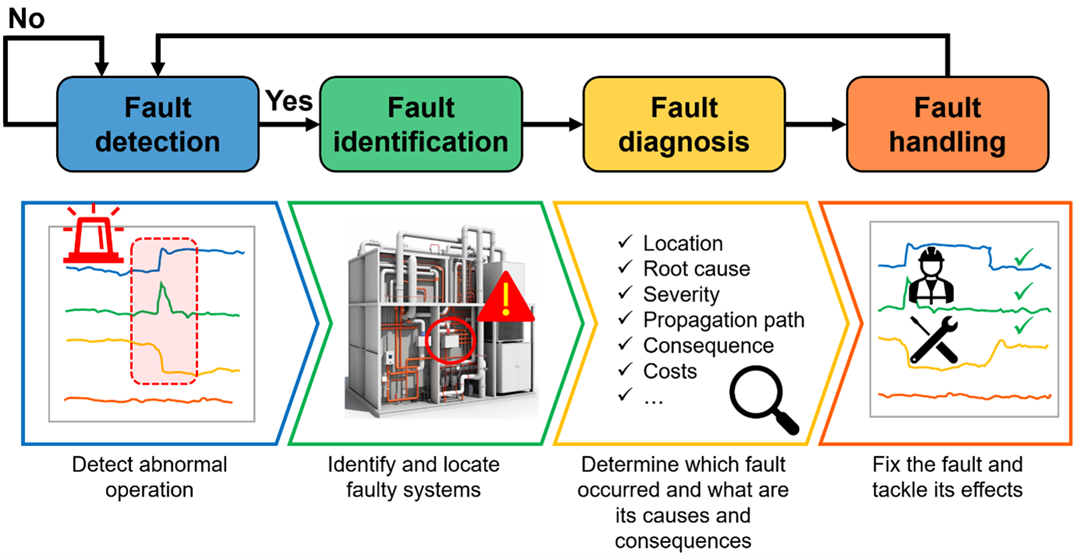Fault Detection and Diagnosis (FDD) has been studied and developed in multiple disciplines of engineering since the 1980s. Faults are very prevalent in building systems and take a significant toll on their performance. It is estimated that faults are responsible for 18 % of the total energy use of commercial buildings in the USA. On any given day, 40 % of the air handling units experience a fault. Detecting and addressing faults in buildings have thus been clearly identified as a key target to reach large energy savings together with a significant improvement of the indoor comfort, productivity, and well-being of building occupants.
If the importance of FDD is well-established for building systems, its systematic implementation and adoption are lacking. Most building operators and managers only perform manual inspections based on user complaints and system critical failures but do not leverage the large amount of data collected by building management and automation systems. Currently, most building management tools are restricted to only help visualize building data. Most of the analysis tools do not perform fault diagnosis (identifying a fault and its cause) but only fault detection by means of data outlier detection or pre-set rules derived from expert knowledge to determine whether the system operates as expected. These methods can perform well but lack portability and transferability to other systems.
The current development of flexible, interoperable and automated FDD solutions for building systems is based on data-driven machine learning methods deciphering intricate patterns and correlations in the operation data to detect, identify and categorize faults. Pinpointing the source and cause of the fault greatly helps the fault handling process (impact analysis, prioritization, and fixing the fault with the appropriate response). It also enables predictive maintenance to tackle systems’ degradation before critical and costly impact occurs.

Nevertheless, a number of barriers and challenges are hindering the faster development and deployment of such data-driven automated FDD: difficult business model, lack of awareness and knowledge among stakeholders, complex return on investment estimates, lack of standardized methods, lack of interoperability in building systems and building communication protocols, siloed business landscape, scarcity of rich and open datasets for the training and benchmarking of FDD and automated FDD algorithms.
The current project aims at generating and curating a high-quality dataset of the operation of air handling units for commercial buildings with emulated faults. This dataset is then used to benchmark existing FDD solutions and develop new ones based on machine learning methods. Finally, the best-performing automated FDD algorithm for air handling units is implemented in a case study office building in Oslo, Norway. This project will reinforce SINTEF and partners’ expertise in machine learning and FDD algorithms while demonstrating the benefits of data-driven machine learning-based solutions to improve energy efficiency and systems’ reliability in office buildings.
Building case: Oslo K, Freserveien 1, 0195 Oslo. Owner: OBOS Eiendom AS
Relevant literature
[1] S. Katipamula and M. R. Brambley, "Review Article: Methods for Fault Detection, Diagnostics, and Prognostics for Building systems—A Review, Part I," HVAC and R Research, vol. 11, (1), pp. 3-25, 2005. DOI: https://doi.org/10.1080/10789669.2005.10391123
[2] J. Gertler, "Fault detection and diagnosis," in Encyclopedia of Systems and ControlSpringer, London, 2015. DOI: https://doi.org/10.1007/978-1-4471-5058-9_223
[3] K. W. Roth, D. Westphalen, P. Llana and M. Feng, "The Energy Impact of Faults in U.S. Commercial Buildings," International Refrigeration and Air Conditioning Conference, 2005. DOI: http://docs.lib.purdue.edu/iracc
[4] H. Kramer, G. Lin, C. Curtin, E. Crowe and J. Granderson, "Building Analytics and Monitoring-Based Commissioning: Industry Practice, Costs, and Savings," Energy Efficiency, vol. 13, (3), pp. 537-549, 2020. DOI: https://doi.org/10.1007/s12053-019-09790-2
[5] E. Crowe, E. Mills, T. Poeling, C. Curtin, D. Bjørnskov, L. Fischer and J. Granderson, "Building Commissioning Costs and Savings Across Three Decades and 1500 North American Buildings," Energy and Buildings, vol. 227, 2020. DOI: https://doi.org/10.1016/j.enbuild.2020.110408
[6] K. Heimar Andersen, S. B. Holøs, A. Yang, K. Thunshelle, Ø Fjellheim and R. Lund Jensen, "Impact of Typical Faults Occurring in Demand-Controlled Ventilation on Energy and Indoor Environment in a Nordic Climate," 2020. DOI: https://doi.org/10.1051/e3sconf/202017209006
[7] O. Nehasil, L. Dobiášová, V. Mazanec, J. Široký, "Versatile AHU fault detection – Design, field validation and practical application", Energy and Buildings, vol. 237, 110781, 2021. DOI: https://doi.org/10.1016/j.enbuild.2021.110781
[8] K.H. Andersen, S.P. Melgaard, H. Johra, A. Marszal-Pomianowska, R.L. Jensen, P.K. Heiselberg, “Barriers and drivers for implementation of automatic fault detection and diagnosis in buildings and HVAC systems: An outlook from industry experts”, Energy and Buildings, vol. 303, 113801, 2024. DOI: https://doi.org/10.1016/j.enbuild.2023.113801


